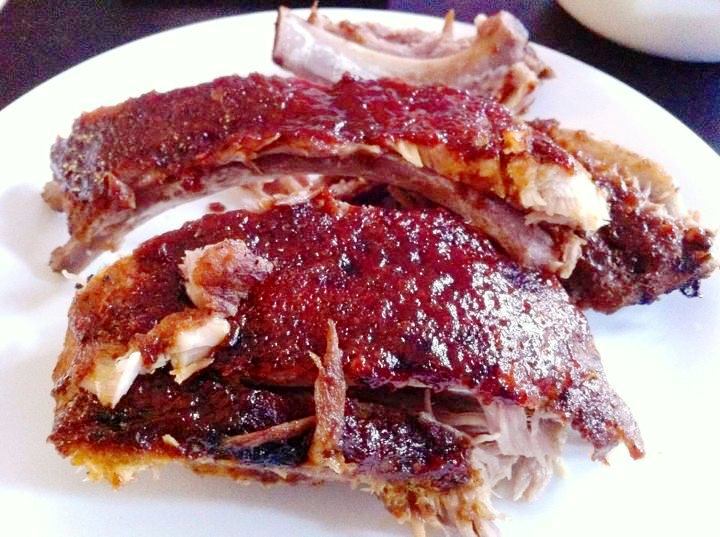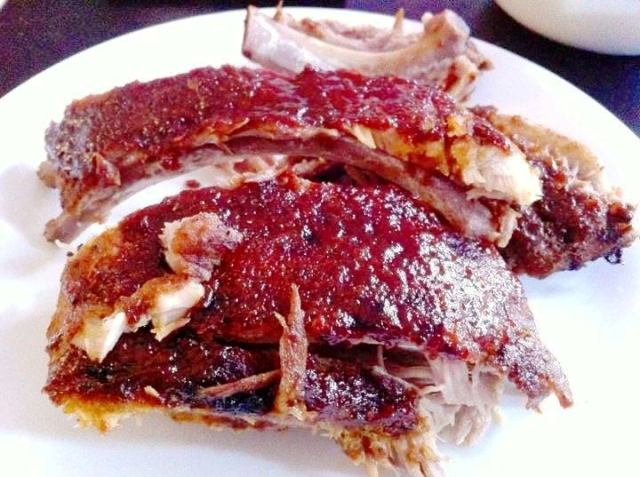Guess what DC? It’s going to be about a million degrees this weekend. That means indoors, AC, shade, or pool. So unless you are a masochist or you have to wear water wings while eating soup, standing in front of a 250-degree grill this weekend for three hours will not be fun.
Luckily I’m about to tell you how you can still have those amazing summertime ribs without all the sweat or the heat of a grill. That’s right’ we’re taking ribs indoors. Now, if you’re anything like me, when you hear someone talk about “oven-cooked” or “baked” ribs, your mind struggles to comprehend this concept and a furious rage begins to build inside you against this abomination of pork preparation. Just the concept invokes images of T.G.I.McChain restaurants and servers with “flare.”
I’m here to tell you that you need not condemn this convenient and easy preparation of God’s lollipops right in your own kitchen – especially if you live in a highly populated urban area where grilling/smoking meat outdoors is not permitted. If prepared and cooked properly, this method can deliver amazingly tender, fall-off-the-bone ribs each and every time. Plus, once you have prepped the meat, seasoned with rub, and wrapped in foil, you can sit back and relax until it’s time to put them in the oven.
Here’s what you do…
The Pork
Procuring quality meat is important. Pork is very temperamental – it must be butchered properly, stored properly, and transported properly. Even if it’s sourced from the best pigs, any flaws in the pre-listed categories could ruin the meat.
If you can find Berkshire pork (and can afford it), then by all means get it and invite me over. This pork comes from Berkshire pigs which are a very rare English breed with fewer than 300 sows in existence. Berkshire pork is known for its tender juiciness, flavor and heavy marbling – remember for meat fat (marbling) means flavor. Contact the American Berkshire Association in the US for more information and ordering guides.
For most of us, Berkshire is a bit out of the question. In the DC area, I prefer to head up to Wagshal’s. They have amazing product. Eastern market also has a wide variety of butchers to chose from, however with pork, I am sometimes weary of their storage and temperature control issues. However, almost anywhere in the US, you can find Smithfield pork – a company founded in 1936 that delivers quality pork products.
The Cut
For this style of cooking, you want baby back ribs (or loin ribs). These are taken from the top of the rib cage between the spine and the spare ribs, just below the loin muscle. They’re a bit meaty than spare ribs, and smaller in size. A typical rack should yield 10-13 ribs (bones). If buying from a butcher and your rack has 10 or less bones, that’s known as a “skim” or “cheater” rack. You are well within your right to ask for a discount or demand a larger rack.
The Prep
Always begin by rinsing the ribs off with cold water. Then, flip them over so the curved side (less meaty side) is facing up. You will see a layer of thin skin; this is the membrane and must be removed prior to cooking. To remove, slide a thin, preferably flexible boning knife along the bone to get under the membrane. Tilt the knife handle up keeping the point against the bone to pry some of the membrane away from the bone. Then, work your fingers under the membrane and pull. It might take a few tries, but it’s worth it. If you don’t or can’t remove the membrane, your guests will have to bite, gnaw, and otherwise tear through it with their teeth as it firms up once cooked.
The Seasoning
Here’s where things can get a bit contentious. Being from Southeastern North Carolina, I have witnessed physical altercations that started with a simple discussion about seasoning ribs. I support fighting over meat…but usually for who gets the last rib. However, if you do find yourself coming to fisticuffs around ribs, the cooked bones break and splinter easily and might make a nice prison shank.
Below is my coveted rub ingredient list and preferred method:
Start by coating the ribs with a spicy vinegar sauce. I use apple cider vinegar, crushed red pepper flakes, ground cayenne pepper, salt, and brown sugar…you can figure out your own ratios.
Now you are ready to liberally apply your rub.
While I have no intention on divulging the exact portions of my dry rub, for you BBQ-virgins out there, any relatively decent dry rub could be made by combining the following: smoked paprika, salt, brown sugar, cumin, chile powder, black pepper, cayenne, onion powder, garlic powder, celery salt, mustard powder and oregano.
Wrap tightly in foil and refrigerate for 12-24 hours.
The Cooking
Take a deep breath, have a drink, and realize you’re about to preheat your oven to cook ribs in. Low and slow is the goal here and remember the lower your temperature, the longer you need to cook them. I prefer 260-275 degrees.
While your oven is preheating, remove your foil wrapped ribs from the refrigerator and let them come to room temperature. When ready, place the wrapped ribs on a cookie sheet on the middle rack.
Cook for 3-3.5 hours or until a internal thermometer reaches 145.
Note: the USDA recommends you cook pork to an internal temperature of 160 degrees. However, we still have some cooking to do, so we want them not quite done yet.
Remove rack from oven and cut foil. Beware of the face searing steam that is about to be released. Peel back the foil so that the top of the ribs are exposed. Place back in the oven for 10-15 minutes until a slight crust or darkened color appears on the top of the ribs.
The ribs are now edible…however, at this point, you do have some finishing options to bring your ribs to the next level.
The Next Level: How to properly finish your oven-cooked ribs
Once the previous steps have been completely, you have 2 options (with variations) to finish your ribs. Essentially, you want to provide a high, direct source of heat at the end of the process. This will crust the skin, sear the rub, or caramelize the sauce should you choose to add.
Option #1 – The Grill
If you have access to a grill, gas or charcoal, bring it to medium-high heat. If you want to sauce your ribs (BBQ sauce or vinegar based), now is the time. Apply sauce to the top/meaty part of the rib; carefully transfer to the grill with the sauced side down (facing the flame). Now, sauce your other side, and flip after 2-3 minutes. What you are looking for is to sear the sauce to the meat, giving it a little bit of color and richness. Sauces have sugar and will burn easily. Now is not the time for all of your hard work to go to waste. Translation: if you have been over-served by this point, please allow someone else to finish off your meaty perfection.
Option #2 – The Broiler
Leave the ribs on their original pan and turn on your broiler. Peel any remaining foil back and sauce the top/meaty part of your ribs as indicated above. Place under the broiler until the sauce has some color to it. There is no real need to flip them and sauce the backside using this method. If your ribs are too hard to transport, (aka already falling off the bone completely), this method may be preferred.
Follow these steps and whether you’re in a studio in Chelsea, an apartment in DC, or the weather doesn’t permit 4 hours of grilling, when your rib craving hits you’ll have perfect ribs each and every time.





You certain do know what youre talking about. Man, this blog is just excellent! I cant wait to read more of what youve got to say. Im truly pleased that I came across this when I did simply because I was truly starting to get bored with the entire blogging scene. Youve turned me around, man!